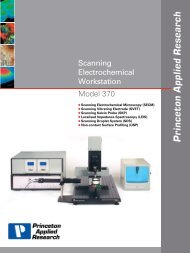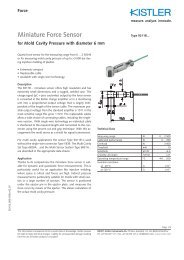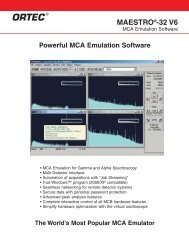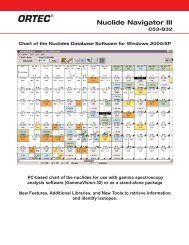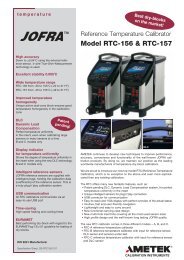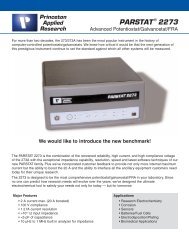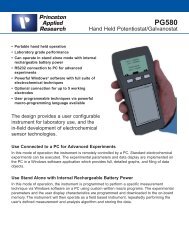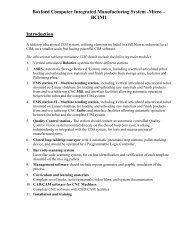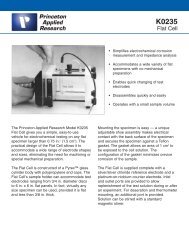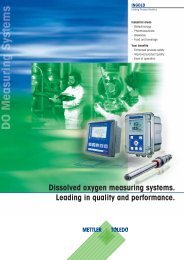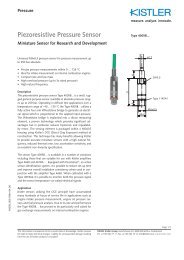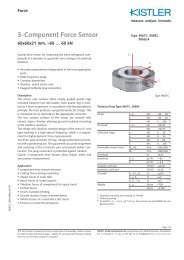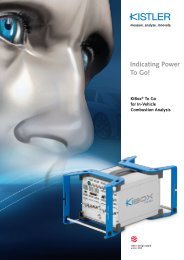Laboratory catalogue
Laboratory catalogue
Laboratory catalogue
You also want an ePaper? Increase the reach of your titles
YUMPU automatically turns print PDFs into web optimized ePapers that Google loves.
Milk laboratory centrifuges<br />
Centrifuges for butyrometric fat determination<br />
according to Dr. N. Gerber<br />
The following points should be observed when acquiring<br />
and operating a centrifuge for fat determination according<br />
to Dr. N. Gerber:<br />
Quiet running<br />
In order to avoid glass breakage and to increase the<br />
service life of the butyrometers, it is most important that<br />
the centrifuge runs with as little vibration as possible. A<br />
distinction is made between the following types of centrifuges:<br />
Type 1: Centrifuge with flay-lying butyrometer<br />
This way of mounting the butyrometers ensures they will be<br />
smoothly treated during centrifugation. However, after centrifuging,<br />
these centrifuges tend to give rise to a renewed<br />
intermixing of the separated phases after centrifugation.<br />
Type 2: Centrifuge with angular rotor:<br />
The angular rotor keeps the butyrometers at a fixed<br />
angle. Unfortunately, this position imposes considerable<br />
stresses on the long and thin neck of the butyrometer.<br />
This type of construction is mostly used in inexpensive<br />
small centrifuges.<br />
Type 3: Centrifuge with swing-out centrifuge buckets<br />
The flexibly mounted butyrometer buckets enable the<br />
butyrometers to swing out horizontally. The butyrometers<br />
are stressed solely along their longitudinal axis. For<br />
this reason, this type of centrifuge is to be preferred to<br />
the other types.<br />
Unbalance<br />
The centrifuge should be equipped with an automatic<br />
unbalance cut-out. The centrifuge will then automatically<br />
switch off in the case of glass breakage (e.g.<br />
breakage of a butyrometer) or if the centrifuge is out-ofbalance<br />
for any other reason.<br />
Cover interlocking<br />
Increasingly and for reasons of safety, a cover interlock is<br />
stipulated in most European countries for all centrifuges.<br />
Heating<br />
The heating of a centrifuge prevents the cooling down<br />
of the butyrometers. This also enables the subsequent<br />
tempering time in the water bath to be kept to a minimum<br />
and leads to a more reliable analysis. The temperature<br />
in the centrifuge bowl must amount to at least<br />
50 °C.<br />
Rotor speed<br />
The determination of fat according to Gerber specifies<br />
a Relative Centrifugal Acceleration (RCA) of 350 g with<br />
a maximum deviation of ± 50 g. The RCA does not<br />
depend only on the rotor speed, but also on the effective<br />
radius. The effective radius is defined as the distance<br />
between the centre point of the rotor and the<br />
outer end of the butyrometer. For this reason, the rotor<br />
speed for the different centrifuge types varies as a function<br />
of their respective radii. However, it is important that<br />
the rotor speed is constant or changes insignificantly<br />
(within the range of tolerance, see above), depending on<br />
whether the centrifuge is fully or only partly loaded. The<br />
RCA is calculated in the following way:<br />
RCA = 1.12 x 10 –6 x R x N 2<br />
N =<br />
RCA<br />
1.12 x 10 –6 x R<br />
whereby:<br />
R = the effective horizontal radius in mm;<br />
N = the rotor speed in rpm [min -1 ].<br />
Example:<br />
A centrifuge with an effective radius of 260 mm needs a<br />
rotor speed of 1100 rpm to be able to reach the specified<br />
RCA of 350 g.<br />
Mounting<br />
Place the centrifuge on a level and solid surface (e.g. a<br />
sturdy table or platform). Air humidity must be kept as<br />
low as possible and the ambient temperature should not<br />
exceed 30 °C.<br />
Routine operation/maintenance<br />
The centrifuge should be charged so as to be as evenly<br />
balanced as possible, i.e. the butyrometers must be uniformly<br />
positioned. In the case of broken glass, the centrifuge<br />
must be cleaned immediately after it has<br />
stopped. This prevents unnecessary corrosion and<br />
ensures a long service life.<br />
Dipl.-Ing. K. Schäfer<br />
32



